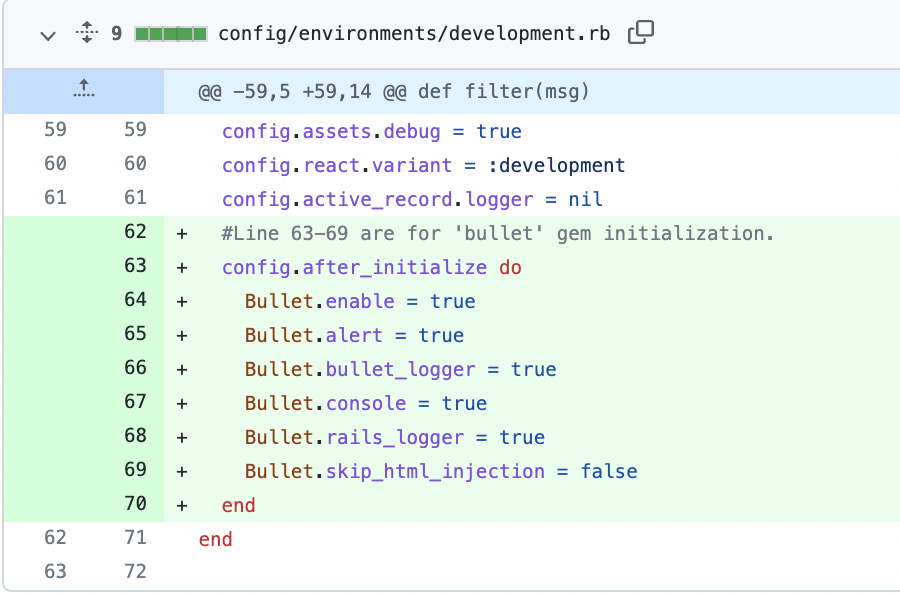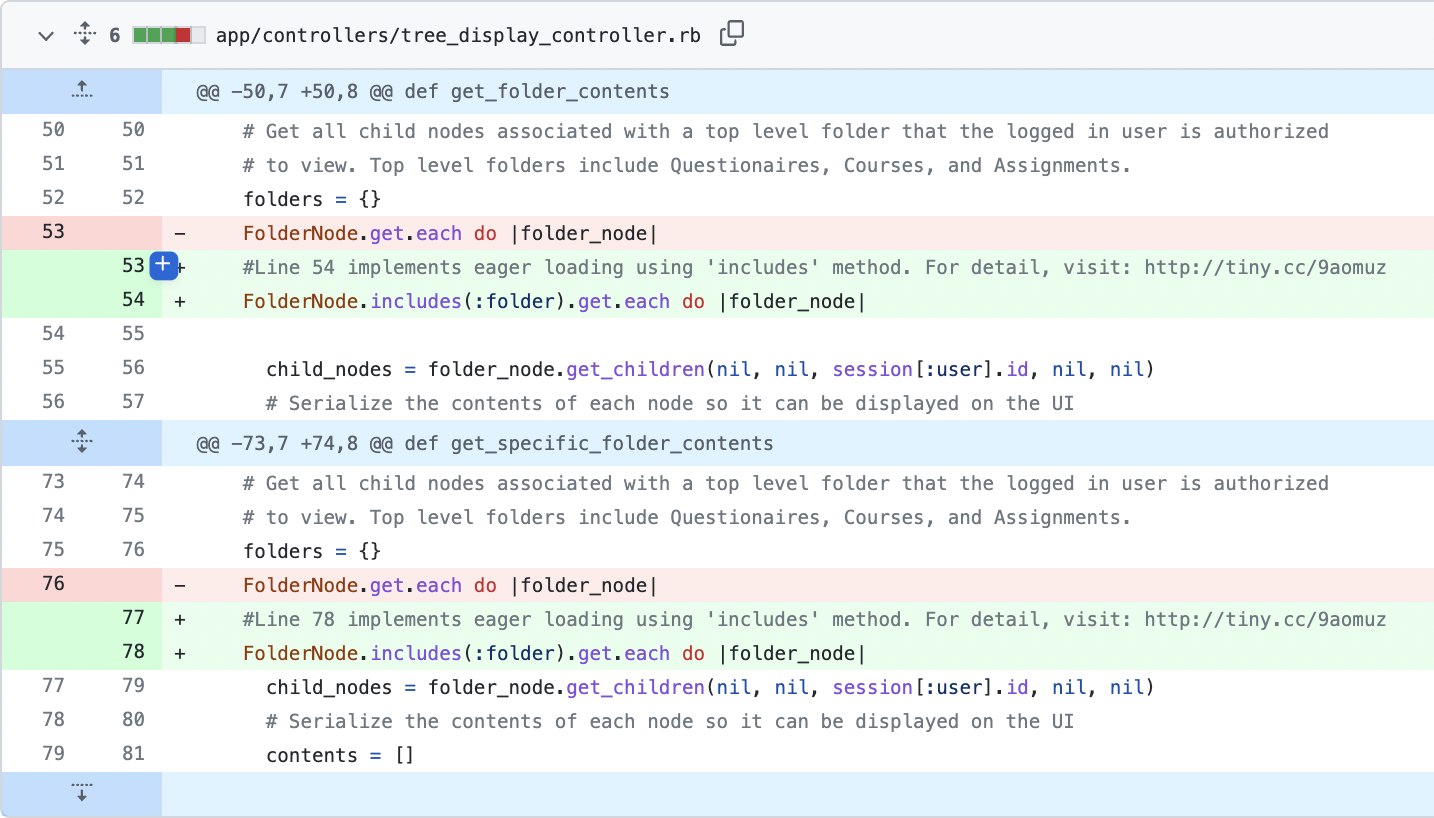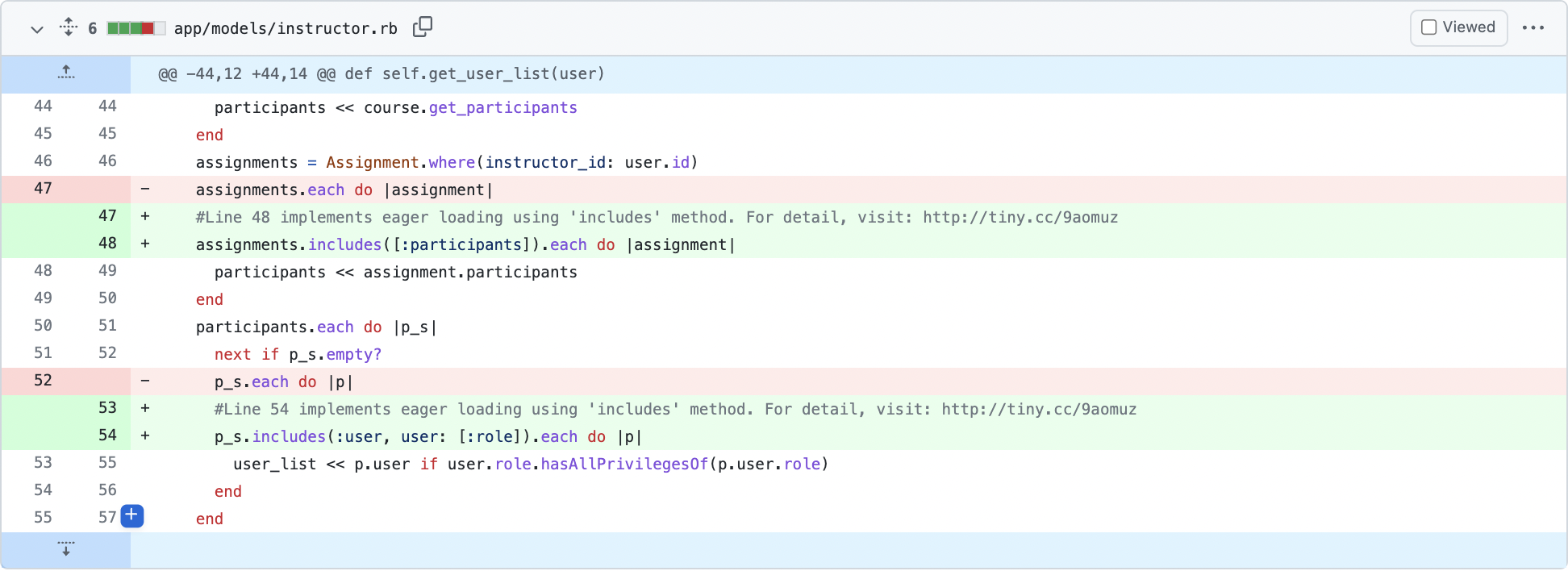Use of bullet gem and .includes to speed up db accesses
Introduction
Team
Dr. Gehringer (mentor),
- Harsh Kachhadia (hmkachha)
- Tirth Patel (tdpatel2)
Background
N+1 problem
In terms of performance, one of the most common problems faced in ORMs is the N+1 query problem. This query problem is a result when a query is made on the result of previous query. That is, when our application tries to retrive data from its database and then loops through the resulting data to get various results. This problem is normally not seen in small applications where the data is small and there are less requests and queries. But if we want to make a scalable application, it becomes important to handle the N+1 query problem from start otherwise the performance of the application will decrease as the application codebase gets bigger and more queries gets fired.
Solution
How eager loading solves the problem
To solve the N+1 problem, we use a process called 'eager loading'. In general, whenever code requests for a resource using db query, a query is fired to the database and the particular resource is fetched. In lazy loading, only the resources required at the moment are fetched and if in future more resources or entities are needed, then additional queries are fired into database. This significantly increases the number of queries fired whenever there is some loop construct in the code. This results into slow page load speed. As opposed to lazy loading, by using eager loading, we load additional required entities which we might require in near future, along with the main resource required by the query. Especially, during loops such as .each, eager loading significantly lowers the page load time, due to less queries fired resulting from additional data loaded from a single main resource query.
For instance, if we are firing a query to fetch all participants, and then loop through all the participants using .each to display their course name, then using eager loading, we can load all the course names for all participants in the same query in which all the participants are fetched from the database, as opposed to individual queries fired to access course names for individual participants in lazy loading.
How 'includes' method helps in eager loading
In Rails, 'includes' method specifies model associations to be included in the result set of the query being fired to the database.
For eg. current_user.participants.includes(:assignment, assignment: [:course]).each{|p| course_ids << p.assignment.course.id if p.assignment and p.assignment.course
Here participants.includes(:assignment, assignment: [:course]) will retrieve all the assignment and course records relating to each participant using 2 queries (1 for participants, 1 for assignments and courses relating to participants), so that when each loop accesses the assignment and course for a participant using 'p.assignment.course' or 'p.assignment', no new query will be fired. This reduces the number of queries using 'includes' method to 2 queries even if we have 1000 participants as compared to 2000 queries.
Bullet Gem
How bullet gem helps in solving N+1 problem
The Bullet Gem has been programmed in such a way that it helps in reducing the number of queries the application makes. This helps in increasing the application performance. When the user runs their application, the bullet gem will watch the queries that the application makes and will notify the user/programmer of the places where eager loading (N+1 queries) can be applied. That is, it will show places where eager loading is needed and where it is not needed.
How to use bullet gem in rails
Adding bullet gem:
To Install:
You can install it as a gem: gem install bullet
or add this into a Gemfile (Bundler): gem 'bullet', group: 'development'
To enable the Bullet gem with generate command: bundle exec rails g bullet:install
The generate command will auto generate the default configuration and may ask to include in the test environment as well. See below for custom configuration in development.rb
Once everything is set, you can run your application. The bullet gem will find places in the code (only the one being used while accessing the application) where eager loading is needed. The user can find the bullet logs at 'logs/bullet.log'
Overview of changes we made during this project
With the use of above mentioned bullet gem, we found the locations in the expertiza code, where eager loading needs to be implemented, by looking at the stack trace recorded in bullet.log file by bullet gem. Bullet gem locates these code locations, as we navigate throughout the website.
For this project, we targeted the following areas of expertiza, those which loads very slow and needs eager loading.
tree_display_controller
- Courses
- Assignments
- Questionnaires
- Users
grades_controller
- view (View scores)
review_mapping_controller
- list_mappings
reports_controller
- Review report
- Author-feedback report
- Teammate-review report
- Answer-tagging report
student_task_controller
- Impersonating a student
We navigated through the UI, that use the code in above mentioned controllers, during which bullet gem located the code locations in these files where eager loading has to be implemented using 'includes' method.
Files that are modified in this project
- tree_display_controller.rb
- feedback_response_map
- instructor.rb
- student_task.rb
- user.rb
- _feedback_report.html.erb
- _flash_notifications.html.erb
- development.rb
- Gemfile
Code changes to resolve N+1 Problem in Expertiza
Courses, Assignments, Questionnaires, Users
- tree_display_controller.rb
Explanation: Here FolderNode.includes(:folder) will retrieve all the folder records relating to each FolderNode using 2 queries (1 for FolderNode, 1 for folder associations relating to folder nodes), so that when each loop accesses the folder for a folder node , no new query will be fired. Thus, reducing the number of queries using 'includes' method to 2 queries as compared to large number of queries which slows down the system.
- _flash_notifications.html.erb
Explanation: Here participants.includes(:assignment, assignment: [:course]) will retrieve all the assignment and course records relating to each participant using 2 queries(1 for participants, 1 for assignments and courses relating to participants), so that when each loop accesses the assignment and course for a participant using 'p.assignment.course' or 'p.assignment', no new query will be fired. Thus, reducing the number of queries using 'includes' method to 2 queries even if we have 1000 participants as compared to 2000 queries.
- user.rb
Explanation: Here User.includes(:parent, :role, parent: [:parent, :role]) will retrieve all the parent and role records relating to each User using 2 queries (1 for User, 1 for parent and role associations relating to User), so that when each loop accesses the parent and role record for a User , no new query will be fired. Thus, reducing the number of queries using 'includes' method to 2 queries as compared to large number of queries which slows down the system.
Review Report, Author Feedback Report
- feedback_response_map
Explanation: Here AssignmentTeam.includes(:users) will retrieve all the user records relating to each team using 2 queries (1 for team, 1 for users associations relating to Team), so that when each loop accesses the user for a team , no new query will be fired. Thus, reducing the number of queries using 'includes' method to 2 queries as compared to large number of queries which slows down the system.
- _feedback_report.html.erb
Explanation: Here @review_responses.includes([:response_map]) will retrieve all the response map records relating to each response using 2 queries (1 for response, 1 for response map associations relating to each response), so that when each loop accesses the response map for a response, no new query will be fired. Thus, reducing the number of queries using 'includes' method to 2 queries as compared to large number of queries which slows down the system.
Impersonating a User
- instructor.rb
Explanation: Here assignments.includes(:participants) will retrieve all the participant records relating to each assignment using 2 queries (1 for assignment, 1 for participants associations relating to assignment), so that when each loop accesses the participant for a assignment , no new query will be fired. Thus, reducing the number of queries using 'includes' method to 2 queries as compared to large number of queries which slows down the system.
Here p_s.includes(:user, user: [:role]) will retrieve all the user and role records relating to each participant using 2 queries(1 for participant, 1 for user and role associations relating to participant), so that when each loop accesses the user and role record for a participant , no new query will be fired. Thus, reducing the number of queries using 'includes' method to 2 queries as compared to large number of queries which slows down the system.
- student_task.rb
Explanation: Here assignment_participants.includes([:assignment, :topic]) will retrieve all the assignment and topic records relating to each participant using 2 queries (1 for participant, 1 for assignment and topic associations relating to participant), so that when each loop accesses the assignment and topic record for a participant , no new query will be fired. Thus, reducing the number of queries using 'includes' method to 2 queries as compared to large number of queries which slows down the system.
Challenges faced during implementation
- Review Report shows 'Nil Class error' when we try to open it. So we couldn't proceed further with it.
- When we tried to improve performance for 'Users' which is basically how fast list of all users in expertiza loads, we found some N+1 issues using bullet gem, but even after fixing all the N+1 issues for users, the page load time improved by just 2-3 seconds which seems like an insignificant changes in page load time as compared to the actual page load time of more than a minute.
- We worked on VCL version of expertiza, which uses Ruby version 2.3, and so the latest version of bullet gem - 6.1.5 works on it seamlessly, but the beta version in original expertiza repository uses Ruby version 2.2.7p, due to which latest version of bullet gem is not compatible with it. As a result, we had to downgrade bullet gem version to 5.7.6 in order to make it compatible with Ruby version - 2.2.7p of beta branch of expertiza GitHub reporsitory.
Testing plan
We aim to perform automatic and manual testing for this project in order to achieve better reliability for this implementation.
As for this project, very few lines of code have been modified in the above mentioned files and also as this is more of a refactoring project, automatic testing was done by checking whether the existing tests pass or not.
Manual testing was done by navigating the UI to the locations using the code from the files that were modified. All manual tests are passed.
Important Links
- GitHub pull request link
- Expertiza wiki page link (the link is mentioned here for records. It redirects to this same page.)
- Github Repository Link for this expertiza fork (make sure you change branch to 'beta' branch if the page doesn't load by default to beta branch)








